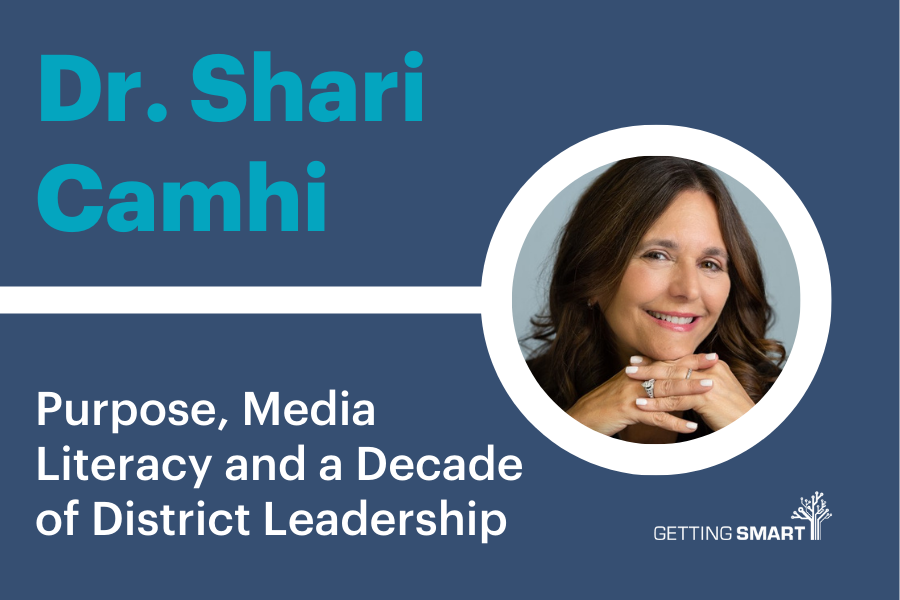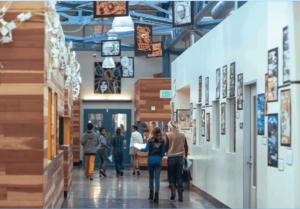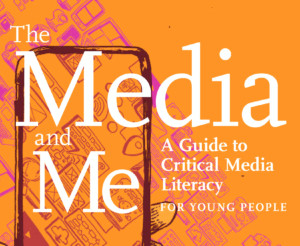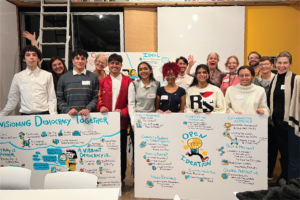Dr. Shari Camhi on Purpose, Media Literacy and a Decade of District Leadership
Key Points
-
Superintendents must be courageous to confront the current moment.

This episode of the Getting Smart Podcast is sponsored by Mrs. Wordsmith, learn more at mrswordsmith.com
On this episode of the Getting Smart Podcast, Tom Vander Ark is joined by Dr. Shari Camhi, Superintendent of the Baldwin School District in Long Island.
Together, they discuss the need for enhanced media literacy in an age where information credibility is increasingly questioned. Additionally, Dr. Camhi shares insights from her decade-long tenure in Baldwin, highlighting how her personal experiences as a parent and educator have shaped her approach to creating diverse, enriching educational experiences. She stresses the importance of adapting education to ensure each student’s unique needs are met, rather than conforming to traditional, one-size-fits-all models. She argues that media literacy is essential for developing critical thinking skills, enabling students to discern between true and false information. The Baldwin School District’s strategy, known as Baldwin 2035, focuses on fostering civic engagement and community connections across all grade levels.

Dr. Shari Camhi
Dr. Shari L. Camhi is the Superintendent of Schools for the Baldwin Union Free School District. With more than three decades of experience in the field of education, Dr. Camhi has not charted the conventional career path, having worked in private industry as a manager of training and development in the field of technology, a visiting “expert” in educational technology overseas, as well as adjunct professor, technology director, assistant superintendent, and currently, superintendent of schools.
In addition to her role as superintendent, Dr. Camhi was elected the 2022-23 president of the National School Superintendents Association (AASA). She has served as a member of the Executive Committee and Governing Board of AASA, the American Association of Community College’s Commission for College Readiness, WNET Business Advisory Council, CoSN K-12 Innovation Advisory Council, and the Cradle of Aviation Museum and Education Center Board of Directors. She was appointed chair/vice-chair of the Educational Telecommunications Service Committee for WLIW, co-chair for the Superintendent/College Presidents Partnership for the Long Island Regional Advisory Council on Higher Education (LIRACHE) and has been an active participant in the Long Island Consortium for Excellence and Equity (LICEE).
Dr. Camhi was one of only twenty school superintendents selected for the Successful Practices Network (SPN) Innovation and Transformational Leadership Network. In addition, she was named Education Week’s “Leader to Learn From,” National School Public Relations Association (NSPRA)’s “New Superintendent to Watch,” Education Dive’s “Administrators to Watch” and was the recipient of the ISTE Sylvia Charp Award for district innovation in technology. Educational leaders and dignitaries from across the country have visited Dr. Camhi’s district to see the success story firsthand. Her district has also been designated a Lighthouse District by AASA and was the only K-12 district to be honored by the New York State Business Council with the inaugural Workforce Innovation Award, among other accolades.
Links
Outline
- Navigating the New Era of Social Media and AI
- The Evolution of Media Literacy in Education
- Revolutionizing High School Experience
- Baldwin 2035: Cultivating Future-Ready Citizens
- Embracing Media Literacy and AI in Education
Navigating the New Era of Social Media and AI
Tom Vander Ark: We are 15 years into the addictive age of social media, and we’re about 15 months into a brand new era of generative AI and building relationships with these new reasoning engines that use natural language processing. Recently, the Wharton professor, Ethan Mollick said, you can no longer believe anything that you see or read. And given that it is time to double down on media literacy.
You’re listening to the Getting Smart podcast. I’m Tom Vander Ark. Today we’re talking to Dr. Shari Camhi. She’s the superintendent on a Baldwin out on Long Island where she’s had a terrific 10-year run. And it’s not only doing great work locally, but work done so well locally that has been nationally influential.
Shari, welcome.
Dr. Shari Camhi: Thanks, Tom. Appreciate you having me.
Tom Vander Ark: We connected when you were president of the School Superintendents Association a few years ago. Has AASA been an important partner for you?
Dr. Shari Camhi: AASA is an incredible partner. Not only do they represent every type of school system around the country but they represent, in my opinion, some of the best thinking that’s going on out there.
Tom Vander Ark: Shari you’ve been in the district just about 10 years and you’ve accomplished so much. I’d love to have you just recount how you built that strategy, how it came together, and what were The key elements,
Dr. Shari Camhi: I think that the work that we all do is best driven by our own experiences.
So I think about my experience as a student, I think about my two kids, their experience as a student, and you can learn a lot from your own personal experiences.
Tom Vander Ark: Now, Shari I’m smiling because I was also superintendent when my kids were teenagers. And man I learned a lot just by being a dad, like going along to registration day, going, wow, this is right, be able to see your system through your kid’s eyes.
Dr. Shari Camhi: And when you have that conversation with yourself that says, Should I say something or not say something? Am I the dad or the school administrator? Who am I?
Tom Vander Ark: Maybe I’ll let my spouse say something.
Dr. Shari Camhi: That’s exactly right.
Tom Vander Ark: Anyway I do appreciate that being a parent is a is primary learning experience.
Dr. Shari Camhi: The perspective I think that I have from my own experiences, from my kids’ experiences, is that school has to be a deep, enriching, experience lots of opportunities that there’s a place for every child, right? I the analogy I use sometimes is that very traditional approaches to learning look like a funnel, right?
It’s wide at the top. You put all of this varied young people in there, but we squeeze them out of one tiny little hole and we hope that they’re all going to come out the same. But the fact of the matter is that, in my school system, I have 4, 600 unique kids. And so I’m not going to have 4, 600 different programs, but I am going to have enough variety that there’s a home for every student.
And I think in part that philosophy along with we’re more than a number and it’s not about being better. It’s about being different, which really drives the thinking here and the design of opportunities for young people.
The Evolution of Media Literacy in Education
Tom Vander Ark: So 2014, we’re like 10 years into Facebook, just starting to gain momentum and Instagrams around … was media literacy on your radar 10 years ago when you started? How does that surface later as a priority?
Dr. Shari Camhi: That surfaces later. In the last six-ten years so much has changed. I know we talk about being exponentially moving that fast and, it scares me to think what the next 10 years are going to be like. I’m not trying to even keep up with it anymore. But it’s not just the availability of the differences in media.
It’s not about the variety, it’s the availability, right? 10 years ago, 15 years ago, every 11 year old didn’t have a $1,500 powerful device in their hands. I think that this idea of information literacy, media literacy, news literacy, whatever you wanna call it, is so important right now because I know you and I have talked forever about critical thinking, but this is critical thinking at its best.
And it’s fundamental. This could be a crisis if we’re not careful about it. You put all that information in the hands of kids. If you don’t give them the filter with which to decipher what it is that’s being fed to them, how do they know the reality of the information?
Tom Vander Ark: Yeah it’s critical thinking under duress though. It’s your right. Your brain has been hijacked by a dopamine producing agent. And then we’re asking you to engage in critical thinking. So it is very different. I want you to talk a little bit more about the strategy and how you want the learning experience to be different, not just a little better, but to be different. What did that look like in elementary school? What did that look like in high school?
Dr. Shari Camhi: So the first thing is, a lot of times when people approach “change” (I feel like I need to put that in quotes because it sometimes has such negative connotation to it) you think, okay I’m going to start in kindergarten and then I’m going to add one grade level every year, but it takes 13 years to get any change.
And in 13 years, everything’s different. So that’s a system that, generally does not work. We’ve really engaged our faculty, our parents, our community in this idea that it is all about the opportunities that you put in front of young people and they fall for us into certain buckets. So there is clearly across the board, a level of civic engagement involved in everything that we do.
We don’t think that you teach civics in isolation. We think that you do civics. And so through social studies, through science, through literacy in elementary school, middle school and high school, there is a component of civics that’s built into everything and that creates really smart, thoughtful, empathetic citizens, and that’s what we’re aiming for.
Focus on everything from K to 12. But if I think, for example, about our high school, we have a whole academy program at our high school, which is not a school within a school. We have really, in the last four years, focused on senior year. Everyone knows the term senioritis, right? We’ve all had it.
Revolutionizing High School Experience
We’ve all had kids who have had it. And so we’ve looked at the senior year and we’ve said, what are the opportunities that we can put in front of young people who are in their last year of high school that keep them engaged, keep them excited And so we have a program with our local community college where kids are full time on campus college students embedded within other courses with college kids.
We’ve started a course called Senior Experience, which combines Social studies, English and business. And our kids are doing civic minded research and capstones and internships in the community for at least half the day, they do not go to class every day at the end of the day.
Their day is different and they love it. They feel involved. They feel important. Their day is different. It’s not the grind of nine periods a day. That’s
Tom Vander Ark: Beautiful, Shari. Like you said, the senior year is usually such a waste, you’re trying to check a couple AP boxes and then taking a few study halls and leaving early. The idea of creating this big block of community-connected work that matters to the learner and to the community is that’s super important. Love that.
Dr. Shari Camhi: I mean, we have kids that are involved in that community college program that have gotten 4. 0 GPAs and 32 credits as a senior in high school. Why are they going to be a senior in high school if they can achieve that in that year, right? So using it a little differently again different not better but thinking about the experiences we want our students to have and designing programs around that.
Baldwin 2035: Cultivating Future-Ready Citizens
Tom Vander Ark: Shari, your strategy, I think you may have called it Baldwin 2035 has this beautiful statement of purpose.
“We will develop citizens with the skills and mindsets to successfully navigate an uncertain and complex world. We will nurture grit, resilience, self awareness, self direction, and personal agency.” Was that developed early in the process?
Dr. Shari Camhi: So that was developed around 2018. That was a collaboration between administrators our teachers, our educator residents, which is another conversation our community was involved in. We used the first six years to set the stage for what’s possible in schools, and then once people had a really good idea of thinking out of the box Baldwin 2035 was born and we work multiple times a year as a full group and then the rest of the year building based.
To give you a sense of that whole idea “different, not better,” we have five elementary schools in the district and all five elementary schools as they define Baldwin 2035 — while the skills and the dispositions that we’re looking for might be the same, the method at which they get there is different from school to school.
It’s not about better. It’s just about different. But in the end, they are all focused on civics. They’re all focused on important skills and community connections. They’re looking at the world bigger than their own environment, whether it’s in Baldwin or in their classroom. They’re just going at it from a different perspective.
Tom Vander Ark: Shari, in 2021, we talked about teacher learning and you were contemplating a teacher residency program and you were looking at like externships where teachers could get out and visit other schools. I think I might be the leading advocate of visiting schools as a professional learning opportunity, but talk about teacher learning and educator development as part of the strategy.
Dr. Shari Camhi: There’s a tie to the name of your podcast, right? “Getting Smart.” What we know about teaching as a profession is most people who become teachers always knew they wanted to be a teacher.
So they went from being students to being college students to being teachers. And what we know about that is you sit in rows and columns, you give information, you test the information, you develop great relationships with young people, and then you move on to your next set. But that’s just not the world anymore, right?
And so we created what we called an Educator Residency Program, where 14 teachers at the secondary level from middle school and high school were involved in professional learning and included in that professional learning were online courses about visible thinking and visible thinking strategies using protocols.
It was going out into the community and doing internships with businesses. So if we talk about preparing our students for the world of work, if the only world of work that you know is being a teacher, how do you know what the world of work is? And so our teachers spent time with lawyers, with businesses, with politicians, with all these different career choices so that they could get a sense of outside of education — “what does the world of work feel like and actually experience it themselves?”
We had them involved in designing leaving to learns. In schools, we call them field trips, right? And so you go somewhere and you do some cool things and then you come back and you use some of it. How deep do you actually go? We call them leaving to learns and they are embedded inside the curriculum. There’s a lot of planning that goes into that.
Embracing Media Literacy and AI in Education
Tom Vander Ark: All right. Let’s talk about media literacy. It just strikes me that the idea of media literacy, the making it a priority, just flows so naturally from your statement of purpose. Cause it’s about developing citizens with the ability to navigate uncertainty and complexity and cultivating resilience, awareness, self-direction, age, agency… all of those things are super central to media literacy. So tell us about what you’re doing. What do you teach? How do you teach it? Where does it surface?
Dr. Shari Camhi: When I think about information literacy, when I was in school, which, granted, was a while ago I could still see the volumes of the world book sitting on my bookshelf, right?
It was a very static way of getting information, but I knew that information went through a vetting process, that if they were printing it on paper, it had to be true. At least I think it had to be true. We’re in a position now where information is just flowing all of the time and we know that there’s information out there that is incorrect. We know there’s information that’s being targeted. I firmly believe that every one of our students must graduate high school knowing how to tell the difference between truth and fiction. That is a fundamental skill that every single person has to have in today’s day and age.
Tom Vander Ark: Yeah, and it just got harder, right?
Dr. Shari Camhi: It gets harder every day, but when you think about it (and without any judgment), if you graduated high school and you could not do geometric transformations, you’d probably be okay, unless you were going into the field of, mathematics or fractals. If you, as a citizen, can’t know if the information that is put in front of you is truthful, we all have a problem. That is a skill that is really fundamental to citizenship. As you mentioned it’s fundamental to personal agency. How do you know, how do you take a stand if you don’t know if the information you’re basing your opinion on is real information? What’s almost more critical is the ability to pivot quickly, right?
Because things change quickly and you need to be able to have the skills to do that. And so we’ve embedded news and media literacy in grade six through 12 in ELA And social studies across the board for every single student. We also have the opportunity for a college level course at the high school level in 12th grade.
It’s part of our participation in government and economics courses as well, but the skills that you need are embedded within the curriculum. And so our students, as they’re writing capstones, as they’re writing research papers, have developed the skills necessary to know if the information that they are putting forward is truthful information before they complete their projects.
Tom Vander Ark: All right. I have to ask if if they are they using a Gen AI to co-author those papers or not?
Dr. Shari Camhi: Here’s what I think. I think that for schools, we’re seeing. We really are at the beginning of this and I think that we haven’t quite defined what it’s going to look like.
If the skills that our kids are going to need after this whole AI revolution gets through whatever it’s going to get through is really knowing if it’s truthful, being able to rewrite, being able to edit being able to create the writing so that it’s in your voice. It’s just a different level of skill, right?
Tom Vander Ark: Right. It may shift to a heavier emphasis on curation, on editing, right? On the voice and choice of creation. But, in just the same way that in the last 15 years many of us have been co-creating in Google Docs, with somebody in the same building or somebody across the planet, we’ve been co-creating in this virtual environment.
And now we have a new team member called Gen AI. It’s a, it is a different way to think about what we produce and how we produce it, it is going to take us a while to get comfortable with that idea though.
Dr. Shari Camhi: I think so. And, we’re going to navigate through that. I think one of the things that’s different about AI is none of us are ignoring it. We’re not pretending like it’s going to go away. We know that it’s here to stay. Initially, I think I know for myself when I would be typing in like word and it would complete my sentences for me at first, I was like, why are you completing my sentence, and now I’m happy not to have to complete the sentence.
But I do think that we are having the conversations around what skills are necessary to be smart in this world that we now live in. How do we use the skills that, or how do we use the tools that are in front of us to our advantage and not be behind the eight ball on that?
Tom Vander Ark: Sure. Here’s The hard question, the Ethan Mollick quote, “you can no longer trust anything your read or see.” It hurts my heart that we have to teach media literacy and lead with skepticism. I think about my own kids, grandkids… and the flip side of this is that Gen AI is this brand new sense of possibility that allows us to create things we couldn’t have imagined to solve problems we couldn’t have imagined. So what I’m most wanting to cultivate is curiosity and possibility. And yet Mollick is saying we have to start with skepticism. So how do we balance those things? Can we embrace the paradox of saying we want to cultivate possibility and curiosity while we’re leading with skepticism?
Dr. Shari Camhi: So I’m not sure I would call it skepticism. I think I would just say, we’re leading with a critical eye. And I think we should have always been leading with a critical eye. Why wouldn’t we want to read something or look at a piece of artwork. We’ve always done that, right? Use artwork. We look at art and we say what does that mean to you? And you look at it critically and you ask yourself those questions, which is all about being creative and being critical thinkers.
And I’m not sure that it’s that different than that? If you put the political lens on it, then yeah, then it’s uncomfortable. And then maybe you do lead with skepticism.
Tom Vander Ark: I like that you went back to critical thinking and if we lead with that it even rewards that notion of curiosity and possibility.
We’re talking to Dr. Shari Camhi. She’s the superintendent in Baldwin out on Long Island. Shari what happens in Baldwin with cell phones? Do you have cell phones in class?
Dr. Shari Camhi: Yeah, so we do not have cell phones in class at all. We do not allow cell phones at all, K-8. And the reason for that has nothing to do with instruction or instructional strategies. It has to do with distraction. I can tell you, I was in a physics class once and I was sitting next to this amazing young man and we were having a great conversation and he took out his phone. He started texting. I said, “You’re not supposed to be doing that.” He just looks at me with this look and he said, It’s my mom. And I said, tell your mom, the superintendent’s sitting right next to you, and she said, don’t text me while I’m in class. So here’s this young man who’s as adorable as can be, and he has a choice: ignore his mom, which, as a mom, I’m going to tell you, you don’t want to ignore your mom, right? Or do something your teacher has told you not to do. It is a distraction. You can get to the information through something other than a cell phone. And, it’s funny when you think about media literacy and, part of that is when you see things posted on Facebook and Instagram and everybody looks beautiful and, okay, so is that real or is it fake, and I think we need to be having these conversations because we need our kids to be confident in who they are. We need them to feel good about themselves. We need them to know that it’s okay to make a mistake, but you need to know how to recover from the mistake.
Tom Vander Ark: Let’s try to wrap this up with some advice for other Edleaders, school and system leaders, like specifically on around media literacy. What do you think they should be doing?
Dr. Shari Camhi: First they need to be doing something right. And we have a partnership with Stony Brook University which has really at least out here, pioneered this. I am doing my part in presenting and introducing them to school systems across the country. So number one is you need to do something. There are multiple universities and organizations around the country that are happy to partner to help navigate the curriculum part of this. And again, I go back: It’s not about better, it’s about different. It fits almost everything, right? Is this something we needed to do before? We all did, triangulation of data. We all did making sure, if the world book said it, then Encyclopedia Britannica said it also. So it’s not about better. It is about thinking differently and making sure that our young people know how to navigate this whole content of thinking.
Tom Vander Ark: And when does media literacy start?
Dr. Shari Camhi: Formally here in a curriculum, it starts in grade six. Grade six through 12 ELA and social studies.
Tom Vander Ark: Shari we started out with with a shout out for AASA, which I think has become very responsive to the context and is providing great direction and support for superintendents. Anybody else that you want to mention that’s been inspirational to you or supportive of the journey that Baldwin schools have been on?
Dr. Shari Camhi: Specifically for Baldwin my school board has been incredibly supportive. Our community has been incredibly supportive. And I don’t say either of those as a political statement, I say that as a hundred percent honest and to go back to your the beginning of your statement, like what kind of advice, I think superintendents need to be incredibly courageous these days.
I think you need to always focus on what’s best for your kids. Thinking about what is their future going to look like and how do you make sure that they’re prepared for their future? It’s certainly not an easy space to be in, in some places, but our community has embraced the thinking, they’ve embraced the work.
I think in part because it’s been clear and understandable. We’ve included them as much as we can include them in the process. They know the purpose of what we’re doing and why we’re doing it. And so that understanding leads to supporting. the work that we’re doing.
Tom Vander Ark: Thanks to Dr. Shari Camhi. She’s the superintendent in Baldwin School District setting a great example by leading on media literacy.









0 Comments
Leave a Comment
Your email address will not be published. All fields are required.